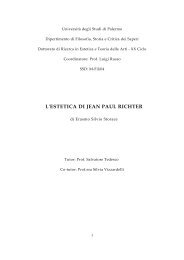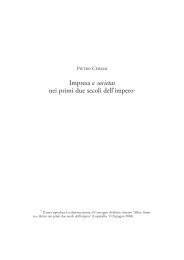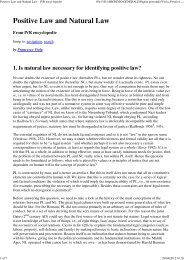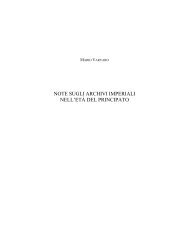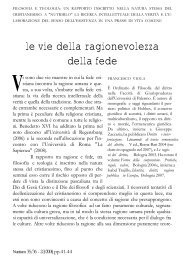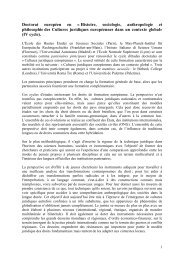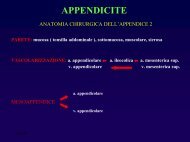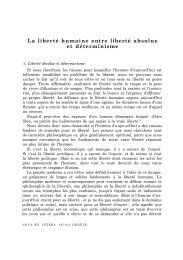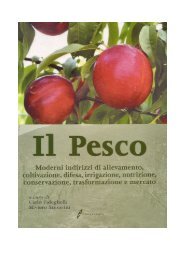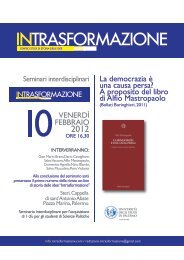F. TERRANOVA, Osservazioni su Gai 2.108 pp. 281 - Università di ...
F. TERRANOVA, Osservazioni su Gai 2.108 pp. 281 - Università di ...
F. TERRANOVA, Osservazioni su Gai 2.108 pp. 281 - Università di ...
Create successful ePaper yourself
Turn your PDF publications into a flip-book with our unique Google optimized e-Paper software.
to dello stesso, non si comprende come mai l’erede o il legatario, che sono<br />
soggetti destinati a trarre un <strong>di</strong>retto vantaggio (o, viceversa, una per<strong>di</strong>ta),<br />
58 possano iure rivestire il ruolo <strong>di</strong> testimoni nel testamento librale.<br />
A ciò si aggiunga un ulteriore problema: come mai <strong>Gai</strong>o esprime,<br />
con una certa cautela, delle riserve soltanto in or<strong>di</strong>ne all’o<strong>pp</strong>ortunità<br />
<strong>di</strong> impiegare come testimone l’erede, e non prende minimamente in<br />
considerazione la situazione del legatario, pur essendo quest’ultimo,<br />
non <strong>di</strong>versamente dal primo, <strong>di</strong>rettamente interessato all’atto?<br />
5. È o<strong>pp</strong>ortuno, anzitutto, rilevare che la raccomandazione espressa<br />
da <strong>Gai</strong>o (quod ad heredem pertinet quique in eius potestate est cuiu<strong>su</strong>e<br />
is in potestate erit, minime hoc iure uti debemus) non rimase senza seguito<br />
e isolata. Un’altra fonte attesta, infatti, il principio in base al quale<br />
‘chi viene istituito erede in un testamento, non può essere testimone<br />
in quello stesso testamento’:<br />
D. 28.1.20 pr. (Ulp. 1 ad Sab.): Qui testamento heres instituitur, in<br />
eodem testamento testis esse non potest. Quod in legatario et in eo qui tutor<br />
scriptus est contra habetur: hi enim testes pos<strong>su</strong>nt adhiberi, si aliud eos<br />
nihil impe<strong>di</strong>at, ut puta si impubes, si in potestate sit testatoris. 59<br />
Il testo in questione, secondo molti, è interpolato laddove è stabilita<br />
l’incapacità dell’erede, 60 in ragione della <strong>di</strong>vergenza rispetto sia a<br />
58 Nel caso, ad esempio, <strong>di</strong> accettazione da parte dell’erede <strong>di</strong> una here<strong>di</strong>tas damnosa.<br />
59 Cfr., <strong>su</strong>l punto, anche Sch. 2 ad B. 21.1.16 (Hb., II, 398); B. 35.1.21 (Hb., III, 542).<br />
60 Così J.J. WISSEMBACHII, Emblemata Triboniani, in Variorum opuscula ad cultiorem<br />
Jurisprudentia adsequandam pertinentia, IX, Pisis 1771, cap. V, 95 s.; F.H. VERING, Römisches<br />
Erbrecht, cit., 210 nt. 5; K.A. VON VANGEROW, Lehrbuch der Pandekten 7 , II, cit., 140;<br />
O. LENEL, Palingenesia iuris civilis, II, cit., col. 1021 nt. 1; F. SCHULZ, Sabinus-Fragmente<br />
in Ulpians Sabinus-Commentar, Halle 1906, 12; F. KNIEP, <strong>Gai</strong> Institutionum, Commentarius<br />
secundus: §§ 97-289 (Testamentarisches Erbrecht), cit., 137; U. COLI, Lo svilu<strong>pp</strong>o delle<br />
varie forme <strong>di</strong> legato, cit., 79 nt. 2; B. KÜBLER, s.v. Testament (juristisch), cit., 988; B.<br />
BIONDI, Successione testamentaria e donazioni 2 , cit., 60 nt. 2; G. SCHERILLO, Corso <strong>di</strong> <strong>di</strong>ritto<br />
romano. Il testamento, II, cit., 15; A. WATSON, The Law of Succession, cit., 33 nt. 6;<br />
M. KASER, Das römische Privatrecht 2 , I, cit., 683 nt. 27; ID., Das römische Privatrecht 2 , II,<br />
cit., 480 nt. 20; R. ASTOLFI, I libri tres iuris civilis <strong>di</strong> Sabino, cit., 59 nt. 3. Cfr. inoltre gli<br />
altri autori citati nell’Index interpolationum quae in Iustiniani Digestis inesse <strong>di</strong>cuntur, II. Ad<br />
libros Digestorum XXI-XXXV pertinens, a cura <strong>di</strong> E. LEVY e E. RABEL, Weimar 1931, 178.<br />
Si esprimono in maniera dubitativa F. GLÜCK, Commentario alle Pandette, Libro XXVIII,<br />
306



